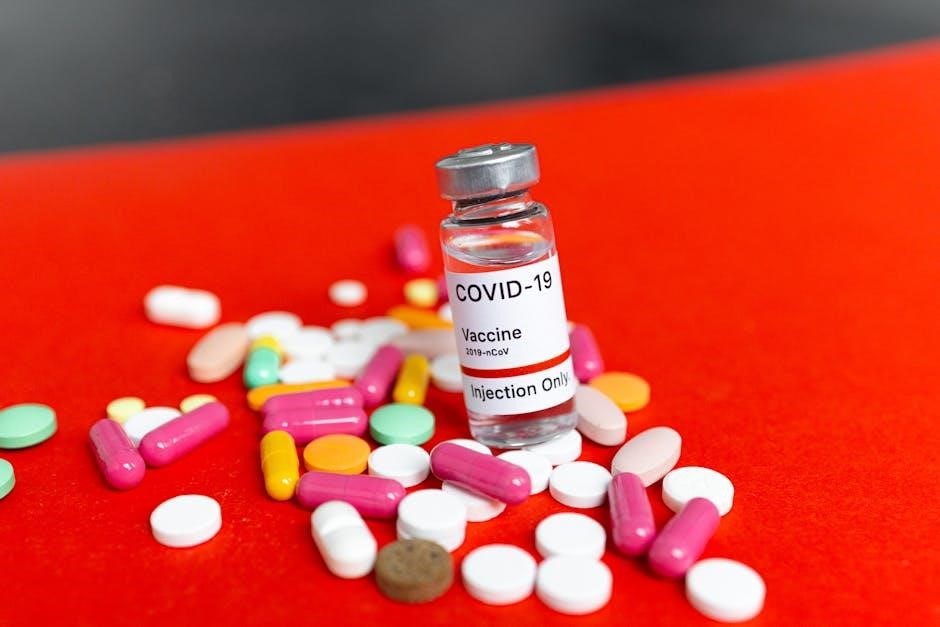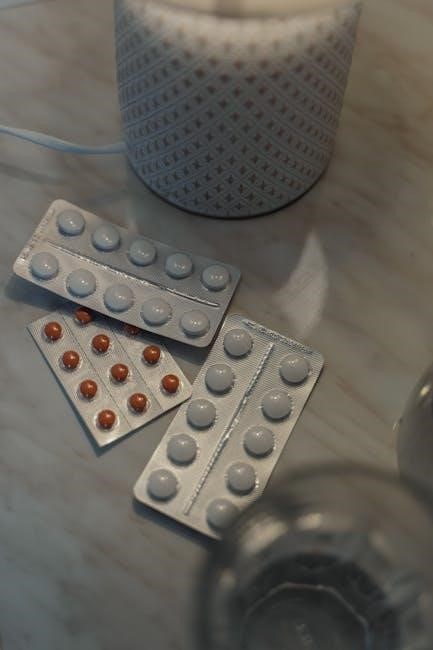Prednisone 10mg dose pack 48 instructions provide guidance for safe and effective medication use. This medication treats conditions like allergies and inflammation, so dosage directions must be followed. The pack typically contains 48 tablets, emphasizing proper administration to avoid adverse effects.

Prednisone dose packs are pre-packaged medications designed to simplify steroid administration and ensure consistent dosages. Understanding these packs is crucial for effective treatment. A typical pack includes multiple tablets, often with a tapering schedule to gradually reduce the dose. This design helps minimize potential side effects and supports the body’s natural cortisol production;
These packs are frequently prescribed for conditions involving inflammation, allergies, or immune system disorders. The instructions are crucial, but some printed on the packet might not be the best approach. The methylprednisolone in Medrol packs equates to prednisone, sharing similar effects. The daily cortisol cycle affects administration timing, ideally taken in the morning.
Dose packs, like Sterapred, have specific tablet quantities for each day. Following the taper is essential to avoid adrenal suppression. Prednisone and methylprednisolone are steroids used to control swelling and pain, so these packs offer a structured method for managing dosages. Always consult a healthcare professional for personalized guidance and address any concerns about side effects or administration.
A 12-day prednisone taper involves gradually reducing the dosage to minimize withdrawal symptoms and allow the adrenal glands to resume normal function. Typically, a 10mg tablet is used, and the total number of tablets will depend on the starting dose. On the first day, a higher dose is taken, followed by a gradual reduction over the subsequent days.
For example, one might start with 6 tablets on day one, then decrease by one tablet each day. It’s essential to take the daily dose in the morning with food, unless otherwise directed by your doctor. This helps align with the body’s natural cortisol rhythm and reduces the risk of insomnia. Always follow the prescribed schedule precisely.
If using a liquid form, a measuring device should be used to ensure accuracy. If experiencing any adverse effects or if symptoms persist, contact your doctor. The goal is to taper slowly enough to prevent adrenal crisis but quickly enough to address the underlying condition. Deviation from the prescribed taper should only occur under medical supervision.
Adhering to the prescribed dosage instructions for a prednisone 10mg dose pack is crucial for both efficacy and safety. Prednisone is a potent corticosteroid, and deviations from the recommended dosage can lead to significant health consequences. Taking too much prednisone can increase the risk of side effects, while taking too little may not effectively treat the underlying condition.
Following instructions also ensures the medication is tapered correctly. Abruptly stopping prednisone, especially after prolonged use, can cause adrenal insufficiency, a potentially life-threatening condition. Tapering allows the adrenal glands to gradually resume their natural cortisol production. Consistent dosage also helps maintain a stable level of the drug in your system.
By precisely following the prescribed schedule, patients can optimize the therapeutic benefits of prednisone while minimizing potential risks. Regular and consistent adherence ensures the body adapts appropriately as the dosage is reduced, leading to a smoother and safer treatment experience. Non-adherence can result in treatment failure or severe withdrawal symptoms.

The timing of prednisone administration is an important factor in maximizing its effectiveness and minimizing potential side effects. It is generally recommended to take prednisone in the morning, ideally before 9 AM. This aligns with the body’s natural cortisol cycle. The body’s cortisol levels are typically highest in the morning.
Administering prednisone at this time can help reduce the risk of sleep disturbances, a common side effect of the medication. Taking prednisone later in the day can interfere with sleep patterns, leading to insomnia or restless sleep. Consistent timing also aids in maintaining a stable level of the drug in the bloodstream, enhancing its therapeutic effect.
Furthermore, taking prednisone with food can help prevent stomach upset, another potential side effect. If a multiple-dose schedule is prescribed, it’s essential to space the doses evenly throughout the day, while still prioritizing the morning dose. Adhering to a consistent timing regimen optimizes the drug’s efficacy and minimizes potential disruptions to daily life.
Prednisone, while effective, carries a range of potential side effects that patients should be aware of. Common side effects include increased appetite, weight gain, and fluid retention, which can lead to swelling in the extremities. Insomnia is another frequent complaint, often stemming from the medication’s stimulatory effects. Mood changes, such as irritability, anxiety, or even euphoria, can also occur.
More significant side effects involve the gastrointestinal system, with some individuals experiencing stomach upset, ulcers, or heartburn. Long-term use can lead to more severe complications like osteoporosis, increasing the risk of fractures. Prednisone can also elevate blood sugar levels, posing a risk for those with diabetes or pre-diabetes.
Additionally, the medication can suppress the immune system, making individuals more susceptible to infections. Changes in appearance, such as a rounded face (“moon face”) or acne, are also common. It’s important to discuss these potential side effects with a healthcare provider to understand the risks and develop strategies for management and monitoring during prednisone therapy.
Managing prednisone side effects involves a multifaceted approach, primarily focused on mitigating discomfort and preventing long-term complications. Dietary adjustments, such as reducing sodium intake, can help manage fluid retention and swelling. A balanced diet, rich in calcium and vitamin D, is crucial to support bone health and counteract the risk of osteoporosis.
To address insomnia, taking the daily dose in the morning can align with the body’s natural cortisol cycle and reduce sleep disturbances. Regular exercise and stress-reduction techniques, like meditation or deep breathing, can help manage mood swings and anxiety.

Protecting against infection is paramount; frequent handwashing, avoiding crowds, and staying up-to-date on vaccinations are vital. Monitor blood sugar levels regularly, especially for those with diabetes, and consult a healthcare provider for medication adjustments if needed. Open communication with your doctor is key to tailoring strategies and addressing specific side effects effectively.
The tapering process is a gradual reduction of the prednisone dosage, designed to allow the body’s adrenal glands to resume their natural cortisol production. It typically involves decreasing the daily dose incrementally over a period, often spanning several days or weeks, depending on the initial dosage and duration of treatment.
Following a structured tapering schedule is crucial to prevent withdrawal symptoms and adrenal insufficiency. The schedule is personalized, based on individual response and medical condition. It should be closely monitored by a healthcare professional. During tapering, patients need to watch for symptoms like fatigue, weakness, body aches, and dizziness, which could indicate the taper is too rapid.
Regular communication with the prescribing doctor is essential to adjust the tapering schedule as needed, ensuring a smooth and safe transition off the medication. The goal is to minimize discomfort and support the body’s natural hormone regulation.
Tapering prednisone is necessary because prolonged use can suppress the body’s natural ability to produce cortisol, a vital hormone. When prednisone is taken for more than a few weeks, the adrenal glands, which normally produce cortisol, may become less active. Abruptly stopping the medication can then lead to adrenal insufficiency, a potentially dangerous condition.
Adrenal insufficiency occurs because the body isn’t immediately able to produce enough cortisol on its own, resulting in symptoms like severe fatigue, weakness, nausea, and low blood pressure. Tapering allows the adrenal glands to gradually resume their normal function, reducing the risk of these withdrawal symptoms.
The tapering process also helps minimize the recurrence of the original condition being treated with prednisone, as it gives the body time to adjust without the medication’s support. It ensures a smoother transition and reduces the likelihood of adverse effects due to sudden hormonal changes.

Prednisone 10mg Dose Pack 48 Instructions
Understanding Prednisone Dose Packs
Dosage Instructions for a 12-Day Taper
Importance of Following Dosage Instructions
Timing of Prednisone Administration
Potential Side Effects of Prednisone
Managing Side Effects
The Tapering Process
Why Tapering is Necessary
When to Contact Your Doctor
It’s crucial to contact your doctor promptly if you experience any unusual or severe side effects while taking prednisone. These could include signs of infection such as fever, sore throat, or persistent cough. Severe abdominal pain, bloody or black stools, or significant mood changes also warrant immediate medical attention.
Additionally, if your original symptoms worsen or do not improve as expected, you should consult your doctor. It’s also important to seek medical advice if you experience symptoms of adrenal insufficiency during the tapering process, such as extreme fatigue, dizziness, or muscle weakness.
If you have any concerns about your dosage, tapering schedule, or potential drug interactions, don’t hesitate to reach out to your healthcare provider for clarification. They can provide personalized guidance and adjust your treatment plan as needed to ensure your safety and well-being.